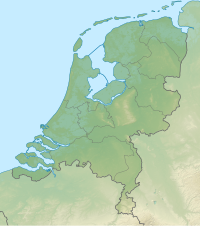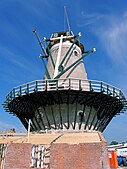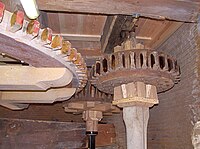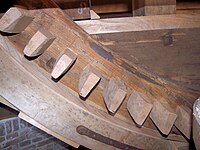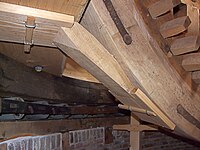Windmill De Korenbloem (Kortgene)
| De Korenbloem
|
||
|---|---|---|
|
Windmill De Korenbloem in Kortgene , Noord-Beveland |
||
| Location and history | ||
|
|
||
| Coordinates | 51 ° 33 '44 " N , 3 ° 48' 8" E | |
| Location | Kortgene , Zeeland , Netherlands | |
| Built | 1873 | |
| Shut down | 1953 | |
| Status | restored and ready for use | |
| technology | ||
| use | Flour mill | |
| Grinder | 1 pair of millstones made of artificial stone 1 pair of millstones made of blue stone |
|
| drive | Windmill | |
| Windmill type | Gallery Dutch | |
| Wing type | Sail gate wing | |
| Number of wings | 4th | |
| Tracking | Harvester | |
| Website | http://www.molenkortgene.nl | |
De Korenbloem (pronunciation De Korenblum , German The Cornflower ) is a flour mill at Molendijk 1 in Kortgene , a town in the Dutch province of Zeeland . The stone windmill is a round gallery Dutchman with 5 levels: grain store, flour, stone, bulk and cap base. The gallery (the balcony surrounding the mill ) is 6.28 m high. The mill was built in 1873 as a replacement for a burned down octagonal ground sail and milled with wind power until 1953 . In 1972 the wings were removed and the cap in 1977 after attempts to restore the mill failed. The wooden cap was covered with roofing felt. Since 2003 De Korenbloem has had new owners who have drawn up a comprehensive plan to restore the mill. In 2009 the mill was transferred to the Stichting Molen De Korenbloem (" Foundation Cornflower Mill "). The official opening took place on October 1, 2011, with the windmill's parking brake (the so-called catch ) being released by Mr. Harry van Waveren, a former member of the Zeeland provincial government .
restoration
The mill was restored to its condition from 1873. The tendering process was started in September 2010 , the work was then awarded to the Berkhof mill construction company from Zwartebroek . The restoration costs were 900,000 euro estimated . The restoration was officially launched on 10 November 2010 with the Heraushieven of from elm wood existing Kammrads from the cap, the upper, rotatable part of a windmill.
The mill was brought out of position with the help of screw jacks and the topmost 1 m high stone layer of the masonry was rebuilt. The bottom of the cap was completely renewed, including the joist layer. The beam heads of the other mill floors were repaired using beta- polymer chemistry . New boards were installed on the floor of the bulk floor.
On May 11, 2011, the new cap was put on the mill. The canopy was largely renewed and covered again with roofing felt. The jar floor was renewed except for the inner edge, the comb wheel was restored. The rearranged iron rods of the windmill blades were manufactured by the Vaags company at the beginning of 2011 . The outer rod with the number 251 is 22 m long, the inner rod with the number 252 measures 21.74 m. On July 5, 2011 the rods were attached. The grating of the mill wings is made of Siberian larch , the front hem and wind boards are made of mahogany . All windboards, not just the storm boards , were fastened with a board spring .
The planks of the gallery, which are made of pressure-impregnated pine , were nailed together so that they do not touch each other.
Mill
The grinding mechanism of the mill consisted of a pair of 16 " thick millstones made of artificial stone with an adjoining pair of 16" thick millstones made of blue stone and a pair of 15 "thick millstones, which were also made of blue stone .
Now both the 16 "thick pair of millstones made of artificial stone and the 16" thick pair of millstones made of blue stone have been returned to their previous location. In recent years, the former mill operation, the millstones were greeted by a 30 hp strong crude oil engine driven in an attached motor shed stood. This shed was later converted into living space . A section of wooden teeth was removed from the comb wheel for grinding operation via the motor . These teeth were then put back for grinding with wind.
The winged cross consisted of two steel rods that lay next to the mill. The inner rod with the number 788 was from 1873 and the outer rod with the number 1415 was from 1884. From 1905 to 1921 the mill had a self- appeasement (a kind of automatic braking mechanism at high wind speeds) first on both wing rods and then until 1944 only on the outer rod. The self-appeasement was operated with the help of a so-called Schwichtring .
The mill was slowed down with the help of a so-called Flemish catch , which also has a support. So it is a combination of a Flemish catch and support catch . With a slowly rotating mill, only the Flemish catch is used when braking, whereas with a high-speed mill the Flemish catch is used first, which pulls the right joint beam slightly inwards and the support catch takes over the braking. The catch consists of six parts that are connected to each other by hinges. The catch is operated using a so-called catching stick .
The cast iron vane shaft from 1872 has the number 826 and came from the manufacturer De Prins van Oranje in The Hague .
The grinder of the mill consists of wooden roller bearings with 42 cast-iron rollers on an iron ring.
The classifier and the mixing vessel are in the grain store . The flour is poured from the flour base into the mixing bowl. The sifter is covered with a filter cloth with a mesh size of 0.25 and 0.50 mm and has twelve outlets: 8 for extract flour , 3 for semolina and one for bran .

Translations
- The gear ratio is 1: 6.68, 1: 6.91 and 1: 7.16.
- The comb wheel has 74 teeth and the crown wheel 31. The upright shaft rotates 2.39 times faster than the vane shaft. The distance between the teeth of the crown wheel is 11 cm .
- The spur gear has 84 teeth and the three stock gears have 28, 29 and 30 teeth, respectively. The stock wheels turn 3 times, 2.89 times or 2.8 times faster than the vertical shaft. As a result, the 16 "grinding stones made of blue stone rotate 7.16 times, the 16" grinding stones made of artificial stone 6.91 times and the 15 "grinding stones made of blue stone 6.68 times faster than the vane shaft. The distance the teeth to each other on the spur gear is 9 cm
owner
- 1868–1876: C. Markusse Jz.
- 1876–1887: J. de Korte Jr.
- 1887–1937: ZC Salomé
- 1937-1967: J. Snoep
- 1967: M. Snoep - Kallewaard
- 1967-2003: LW Kokee
- 2003-2009: G. en L. de Boer
- since 2009: Stichting Molen "De Korenbloem" (" Mill Foundation" De Korenbloem " ")
Photo gallery
Web links
- Mill Foundation website (Dutch)
- Korenbloem: Website of the tourist association VVV Zeeland (German, Dutch, English)
- First rotation test on July 7, 2011

